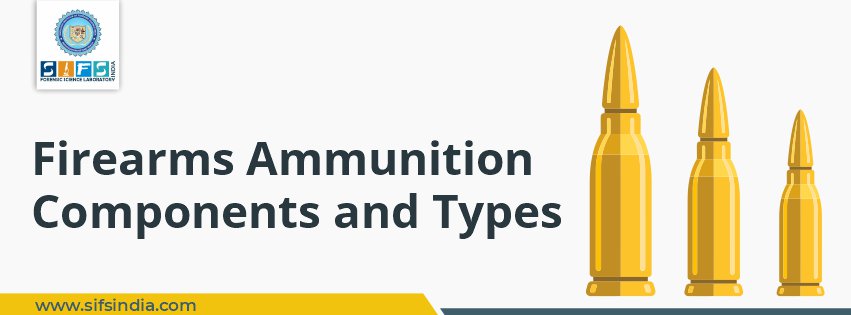Ammunition of any firearm can be defined as the cartridge along with the projectile and the propellants and can be used for firing from any weapon. It is also defined under Section2-1 (b) of the Indian Arms Act, 1959.
No firearm can be used without the proper ammunition or any of its components.
It can be categorized as:
a) Rifled Ammunition: The ammunition which can be used in the rifled bore firearms and consists of bullets instead of pellets are known as Rifled Ammunitions.

Types of Ammunition
b) Shotgun Ammunition: This is defined as the ammunition which is used in smooth-bore firearms consisting of pellets instead of bullet along with various types of wads.
Firearm Ammunition Components and Types
Ammunition is also known as a live cartridge consists of various components that are:-
1) Cartridge case: The casing provides housing for all the other components of the ammunition which include primer, primer cap, propellants, wads (in case of shot guns), and projectile (bullet of pellets).
It is usually made up of brass for rifled ammunition and of paper or cardboard for shot-gun ammunition. The base of the case could be rimmed or rim-less.
2) Primers: It is defined as a high-explosive material which is pressure sensitive and helps in producing flames and igniting the propellant charge.
Previously, lead azide was used as a primer but various components used nowadays as primers can be Mercury fulminate, Antimony Sulphide, Lead Styphnate, etc.
3) Propellants: It helps to give the projectile the appropriate amount of force to expel the projectile out from the muzzle end of the barrel.
It gets ignited by the primer which helps the propellant charge to convert in gaseous form quickly which develops high pressure inside the cartridge case expelling the projectile out from the barrel.
It can be divided into 3 types:
a) Black powder (Gun Powder): It was the oldest propellant which was invented by the Chinese. It composes of Potassium Nitrate, Sulphur and Charcoal approximately in the ratio of 75:15:10 respectively. It is mostly used in blank cartridges and muzzleloading firearms.
b) Smokeless Powder: The major components of smokeless powder are nitrocellulose (gun cotton) and nitroglycerine. This can be either single-base, double base or triple base depending on the composition.
If nitrocellulose is used alone it is termed a Single-base powder, if used in combination with nitroglycerine then it is termed a Double-base powder. Also rarely Triple-base powder can also be used which also consists of black powder along with others used in double-base.
c) Semi-Smokeless Powder: It is the mixture of black powder and nitrocellulose in the ratio of 20:60:12:8 i.e. Nitrocellulose, Potassium Nitrate, Charcoal, and Sulphur respectively. It produces comparatively less smoke but its mixing procedure is dangerous.
4) Wads: Wads are used in shotgun ammunition rather than rifled ammunition to separate the various components of the ammunition and keep them in their respective positions.
These can be classified on the basis of their position as:- Over-powder wad, a cushion wad, an Under-shot wad and an Over-shot wad. These are made up of cardboards of varying thicknesses depending on the type.
5) Projectile/s: This is different in different weapons such as rifled firearms consisting of ammunition having bullets while shotgun firearms consist of ammunition consisting of pellets.
These are expelled out from the muzzle end of the firearm which may hit the target by the pressure created by the propellant charge inside the barrel. These are mostly made up of lead.
During the firing mechanism the ammunition is fired and the components of it expels the left case is known as the cartridge case which can be either rim-fire (when the firing pin strikes the edge of the rim) or center-fire (when the firing pin strikes the center on the primer cap) the components of the ammunition starts to ignite and forces the projectile out through the muzzle end of the barrel.
Every piece of evidence contains a hidden truth. From meticulous crime scene analysis to cutting-edge digital forensics, our expert team is dedicated to decode mystery within every clue. Discover how our specialized forensic expertise can support your investigation.
Call on +91-11- 47074263 or WhatsApp +919953546546
Forensic Lab Expert Services

 December 12, 2021 - BY SIFS India
December 12, 2021 - BY SIFS India
